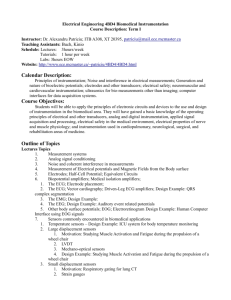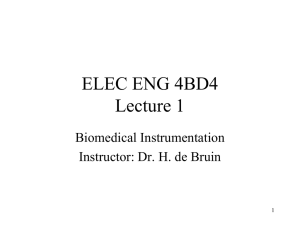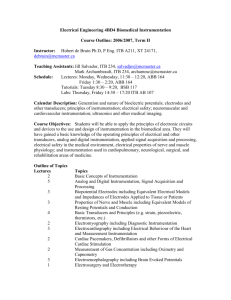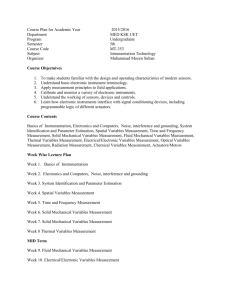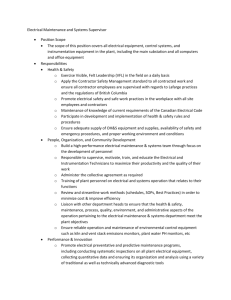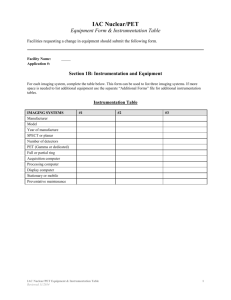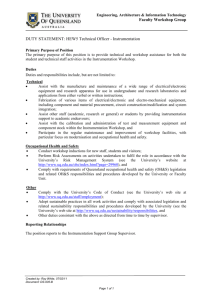Electrical Engineering 4BD4 Biomedical Instrumentation
advertisement
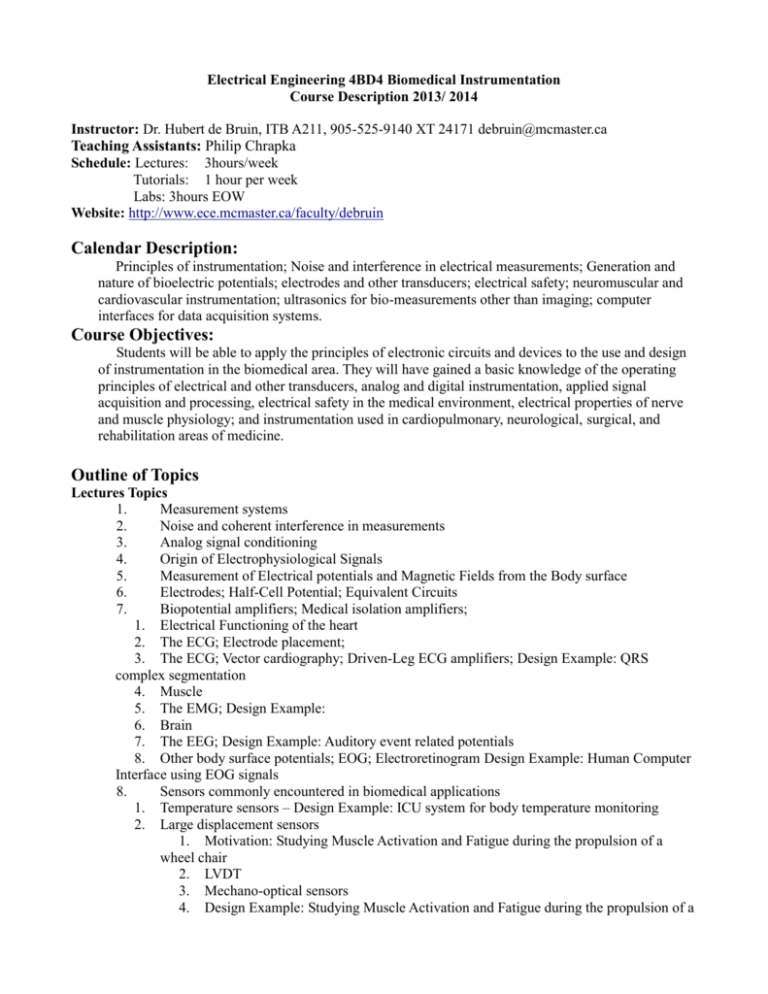
Electrical Engineering 4BD4 Biomedical Instrumentation Course Description 2013/ 2014 Instructor: Dr. Hubert de Bruin, ITB A211, 905-525-9140 XT 24171 debruin@mcmaster.ca Teaching Assistants: Philip Chrapka Schedule: Lectures: 3hours/week Tutorials: 1 hour per week Labs: 3hours EOW Website: http://www.ece.mcmaster.ca/faculty/debruin Calendar Description: Principles of instrumentation; Noise and interference in electrical measurements; Generation and nature of bioelectric potentials; electrodes and other transducers; electrical safety; neuromuscular and cardiovascular instrumentation; ultrasonics for bio-measurements other than imaging; computer interfaces for data acquisition systems. Course Objectives: Students will be able to apply the principles of electronic circuits and devices to the use and design of instrumentation in the biomedical area. They will have gained a basic knowledge of the operating principles of electrical and other transducers, analog and digital instrumentation, applied signal acquisition and processing, electrical safety in the medical environment, electrical properties of nerve and muscle physiology; and instrumentation used in cardiopulmonary, neurological, surgical, and rehabilitation areas of medicine. Outline of Topics Lectures Topics 1. Measurement systems 2. Noise and coherent interference in measurements 3. Analog signal conditioning 4. Origin of Electrophysiological Signals 5. Measurement of Electrical potentials and Magnetic Fields from the Body surface 6. Electrodes; Half-Cell Potential; Equivalent Circuits 7. Biopotential amplifiers; Medical isolation amplifiers; 1. Electrical Functioning of the heart 2. The ECG; Electrode placement; 3. The ECG; Vector cardiography; Driven-Leg ECG amplifiers; Design Example: QRS complex segmentation 4. Muscle 5. The EMG; Design Example: 6. Brain 7. The EEG; Design Example: Auditory event related potentials 8. Other body surface potentials; EOG; Electroretinogram Design Example: Human Computer Interface using EOG signals 8. Sensors commonly encountered in biomedical applications 1. Temperature sensors – Design Example: ICU system for body temperature monitoring 2. Large displacement sensors 1. Motivation: Studying Muscle Activation and Fatigue during the propulsion of a wheel chair 2. LVDT 3. Mechano-optical sensors 4. Design Example: Studying Muscle Activation and Fatigue during the propulsion of a 3. 4. 5. 6. wheel chair Small displacement sensors 1. Motivation: Respiratory gating for lung CT 2. Strain gauges 3. Piezoelectric transducers 4. Design example: Respiratory gating for lung CT Pressure measurements – 1. Invasive blood pressure measurements 2. Automatic non – invasive blood pressure measurements 3. Design Example: Design a non-invasive blood pressure measurement system Electro-chemical sensors – noninvasive blood gas sensing with electrodes Optical sensors – Pulse Oximetry Plethysmography; volume displacement; impedance Ultrasound - Doppler US for blood and tissue velocity measurements Stimulation of excitable tissues; Cardiac pacing and defibrillation Digital Interfaces in measurement systems; Sampling Theorem; Quantization Noise; 9. 10. 11. 12. Dithering; 13. Digital to Analog converters; Analog to digital converters Laboratory Sessions: Lab 1 : Differential amplifiers; DAQ / DSP / Statistical Analysis Key Concepts: Discrete Signals, Acquisition, Amplifiers, Frequency Domain Lab 2 : ECG / Heart Rate Key Concepts: Biopotentials, Electrocardiogram, Einthoven's Triangle, Noise Artifact, Bioinstrumentation amplifier for ECG Lab 3 : EEG Key Concepts: Alpha & Beta Waves (Alpha Blockers) – in phase or out of phase. Spectral and time analysis, Irregularities, Bio-instrumentation amplifier for EEG Lab 4 : EMG & Motor Control Key Concepts: Muscle twitches, rectification, averaging, RMS, Force vs EMG, Filtering effects on applications of EMG, Bio-instrumentation amplifier for EMG Lab 5 : EOG & Environmental Control Key Concepts: DC Signals, DC Amplifiers, Frequency component of blinking, Scaling of signals and creation of algorithms to make raw data into useful information, Bio-instrumentation amplifier for EOG Format Full class sessions and tutorials including demonstrations of current clinical instrumentation and measurements. Assessment: Labs 10% Midterm 30% Homework 10% Final Exam 50% Calculator requirement for tests and examinations: The McMaster standard calculator (Casio fx991) Textbooks (Optional): 1. Medical Instrumentation: Application and Design. John G. Webster 2. Custom Courseware, Lecture Notes posted on the class website Additional resources: 1. Introduction to Instrumentation and Measurements; Second Edition; Robert B Northrop; Taylor and Francis; ISBN 0-8493-3773-9 2. Noninvasive Instrumentation and Measurement in Medical Diagnosis; Robert N. Northrop; CRC press; ISBN 0-8493-0961-1 3. Design and Development of Medical Electronic Instrumentation, D. Prutchi and M. Norri, WileyInterscience, 2005 Additional Statements: The instructor(s) reserves the right to choose the format (i.e. written or oral) of any deferred midterm or exam in this course. Please note that announcements concerning any type of graded material may be in any format (e.g., announcements may be made only in class). Students are responsible for completing the graded material regardless of whether they received the announcement or not. The instructor and university reserve the right to modify elements of the course during the term. The university may change the dates and deadlines for any or all courses in extreme circumstances. If either type of modification becomes necessary, reasonable notice and communication with the students will be given with explanation and the opportunity to comment on changes. It is the responsibility of the student to check their McMaster email and course websites weekly during the term and to note any changes. Policy Reminders: “The Faculty of Engineering is concerned with ensuring an environment that is free of all adverse discrimination. If there is a problem that cannot be resolved by discussion among the persons concerned, individuals are reminded that they should contact the Department Chair, the Sexual Harassment Officer or the Human Rights Consultant, as soon as possible.” “Students are reminded that they should read and comply with the Statement on Academic Ethics and the Senate Resolutions on Academic Dishonesty as found in the Senate Policy Statements distributed at registration and available in the Senate Office” "Academic dishonesty consists of misrepresentation by deception or by other fraudulent means and can result in serious consequences, e.g. the grade of zero on an assignment, loss of credit with a notation on the transcript (notation reads: "Grade of F assigned for academic dishonesty"), and/or suspension or expulsion from the university. It is your responsibility to understand what constitutes academic dishonesty. For information on the various kinds of academic dishonesty please refer to the Academic Integrity Policy, specifically Appendix 3, located at http://www.mcmaster.ca/senate/academic/ac_integrity.htm The following illustrates only three forms of academic dishonesty: 1 Plagiarism, e.g. the submission of work that is not one's own or for which other credit has been obtained. 2 Improper collaboration in group work. 3 Copying or using unauthorized aids in tests and examinations.
